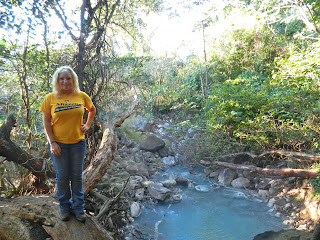"Lions, tigers and bear's oh my!"
As I hiked through numerous forests and jungles in Costa Rica thoughts of wildlife were not far from my mind. Luckily, I did not have to worry about too many dangerous predators. Most jungle experts consider jaguars to be the most dangerous threat. Sitings of jaguar's are extremely rare, as the animals are nocturnal and tend to avoid human contact. Despite knowing that, I always asked locals if they had ever spotted a jaguar. Almost all of them said they had never run into a jaguar- and they hoped to keep it that way! My professor, Bill Allen, happened upon a jaguar during his first trip to Costa Rica. He vividly described his encounter with the jaguar in his novel, Green Phoenix. He always regretted not photographing his "jaguar moment". But I did not blame him for forgetting his camera when faced with a jungle predator. Despite my worry, and excitement, about jungle wildlife, the beauty of the jungle astounded me.
Walking through the forrest was like entering another world. This world was filled with brilliant shades of green, countless species of wildlife and tranquil peace. As I explored trails, narrow dirt paths, I found myself feeling as though I was a part of nature. Often I would pause for a moment and simply take the landscape in. The sounds, feelings and scents of the land were unique and I treasured the moments I spent in the forrest. Our tour group took many hikes through the landscapes of Costa Rica. We traveled by volcanos, over rope bridges, to waterfalls and even discovered groves of monkeys. Being surrounded by exotic plants and leafy-green foliage was a change of scenery from the farm life I was used to.
Breathtaking Costa Rican streams flow through the forests from the mountain tops.
Walking across rope bridges to the jungle!
Hiking boots were a must here! You had to be alert for snakes among the rocks. Being on the lookout for snakes was normal for me, rattle snakes are very common in northwest Missouri.
Our group was astounded at this nature novelty. Steam rose from the ground in these crater-like natural landmarks.
You never know what you will find on a jungle trail. Our nature guide was not sure of the significance of this handprint and it puzzled my fellow students and I.
Green was a common occurrence here.
Exotic plants were everywhere and added hints of color to the landscape.
Mist from nearby volcanic areas.
This pool was the purest shade of aquamarine I had ever seen. However, do not think about taking a dip in it. Temperatures reach over 100 degrees Celsius in it.
After climbing a volcano and mountain ridden land for seemingly forever, we reached a waterfall. The waterfall appeared to be something straight out of a movie scene!

















































